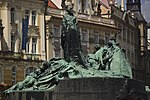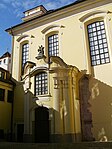Old Town Square execution
1621 in the Habsburg monarchy17th-century executions in the Holy Roman Empire17th century in PragueBohemian RevoltMassacres in the Czech Republic ... and 3 more
Military history of PragueOld Town SquareUse mdy dates from May 2018

Old Town Square execution (Czech: Staroměstská exekuce) was the execution of 27 Bohemian leaders (three noblemen, seven knights and 17 burghers) of the Bohemian Revolt by the Austrian House of Habsburg that took place on 21 June 1621 at the Old Town Square in Prague. After the Prague Defenestration in 1618 and subsequent Protestant uprising of the Bohemian estates against the Catholic Habsburgs resulted in the Thirty Years' War and a final defeat in the Battle of White Mountain, Habsburgs took their revenge and executed some of the key leaders of the uprising, although with some others the punishment was reduced and some were pardoned.
Excerpt from the Wikipedia article Old Town Square execution (License: CC BY-SA 3.0, Authors, Images).Old Town Square execution
Prague Old Town (obvod Praha 1)
Geographical coordinates (GPS) Address Nearby Places Show on map
Geographical coordinates (GPS)
| Latitude | Longitude |
|---|---|
| N 50.0872 ° | E 14.4209 ° |
Address
110 00 Prague, Old Town (obvod Praha 1)
Prague, Czechia
Open on Google Maps










